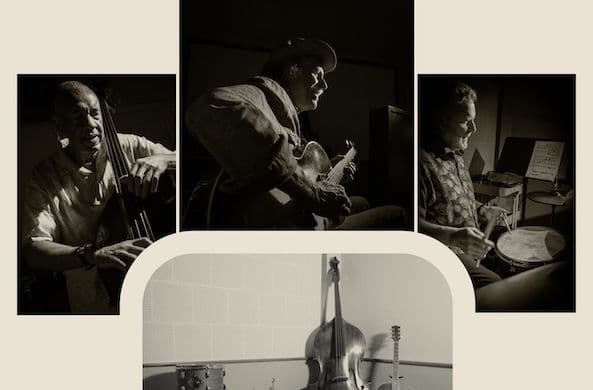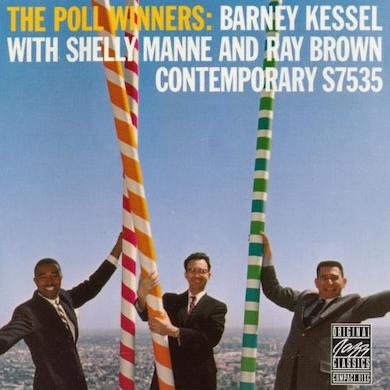Call Them Students, Acolytes, Devotees, or Disciples: They’re All Winners
On ‘Reunion,’ Bruce Forman, John Clayton, and Jeff Hamilton cover and rearrange the music of Barney Kessel, Ray Brown, and Shelly Manne, who made five ‘Poll Winners’ albums starting in 1957.

Bruce Forman With John Clayton and Jeff Hamilton
‘Reunion’ (B4Man Music)
In a reference that now seems obscure at best, the cover of a 1957 album called “The Poll Winners” shows three men in suits perched on a hill against an expansive backdrop of California scenery. They cling to what appear to be colorful, gigantic straws; just picture King Kong ordering a Diet Coke. These are actually poles, and they comprise a visual pun, referring to how the gentlemen all won readers’ polls (get it?) for their specific instrument in the three magazines — Down Beat, Metronome, and Playboy — that then covered jazz.
They were guitarist Barney Kessel (1924-2004), bassist Ray Brown (1926-2002), and drummer Shelly Manne (1920-1984). Their original “Poll Winners” album was so well-received that they followed it with three more through 1960, and then, 15 years or so later, reunited for a fifth. Forty-five years after that, a new reunion of the poll winners — at least in spirit — has been recorded and released.

Bruce Forman, John Clayton, and Jeff Hamilton were all students of Kessel, Brown, and Manne, or call them acolytes, devotees, disciples, or whatever term you want. Not only that, they have inherited the actual instruments — the guitar, bass, and trap drum kit — that the original poll winners played on these albums.
The original poll winners apparently made at least a few appearances at Los Angeles clubs between 1957 and 1960. Likewise, Messrs. Forman, Clayton, and Hamilton have also performed live on the West Coast, including a recent show at Palm Springs that I was fortunate to attend. They also have made an album, fittingly titled “Reunion.”
Barney Kessel also toured all over the world, mostly working in the same format of guitar, bass, and drums; it was the perfect expression of his musical vision. The sound of the threesome was cool and uncluttered, with just enough support, both harmonic and rhythmic, to perfectly showcase the solo electric guitar.
Kessel was the star and the driving force, but this was a unit in the same class as the piano-centric trios of Bill Evans and Ahmad Jamal, in which all three players operated on a level playing field — three leaders who formed a true cooperative, never getting in each other’s way.
None of the original trio was native Californian (they were from Oklahoma, Pittsburgh, and New York, respectively), but they all were major figures in the West Coast Jazz scene of the 1950s. “Reunion” opens with “Ropeadope,” a California-dreamin’ kind of a blues, bursting with more sunshine than sorrow. Another original blues, Mr. Clayton’s “BRS,” short for Barney, Ray, Shelly, leaves lots of open spaces for spirited trades of fours between the three principals.
They don’t offer any specific recreations of original poll winners tracks, but they do drop hints all over the place. “Gravy Waltz” spotlights Mr. Clayton playing the melody of this 1961 Ray Brown tune, introduced by the bassist-composer with Oscar Peterson’s trio on the famous London House live recordings.
“April in Paris” is another stunning example of what we once called “jazz repertory,” which usually means overtly referencing iconic solos or arrangements. In this case, the three-man ensemble does an excellent job of recreating one of the most famous jazz charts ever, the Wild Bill Davis / Count Basie version of “April in Paris.” Another legendary arrangement, the finger-snapping, bass-centric intro to Peggy Lee’s “Fever,” provides the framework for the trio’s treatment of the Coasters hit “Love Potion #9.”
In general, their new arrangements of the standards are at least as varied and surprising as the new originals. “Star Dust” is mostly rubato, transforming Hoagy Carmichael’s verse into a kind of opening cadenza, then settling into a groove with the chorus, with a spot for a solo by Mr. Clayton along the way. They recast “Green Dolphin Street” with a wildly Spanish, flamenco setting, i.e., “Sketches of Green Dolphin Street.”
Kurt Weill’s “This is New” proves that the new poll winners can effectively play both a ballad and a swinger at the same time. It opens romantically with a reprise of Kessel’s iconic intro to Julie London’s “Cry Me a River,” but then quickly shifts into swingtime, returning to the original slow love song tempo again at the end.
This is, indeed, a new way of playing “This is New,” and it speaks for the whole album: something old but something new all at once. Now all they need to do is shoot a cover photo with the three players dangling from giant pixie-sticks.
Correction: The original poll winners apparently made at least a few appearances at Los Angeles clubs. Their touring status was misstated in an earlier version.

